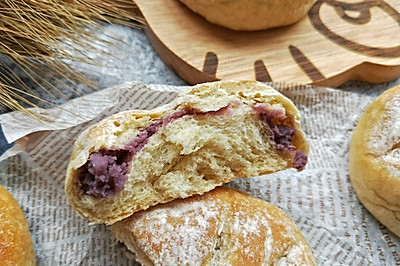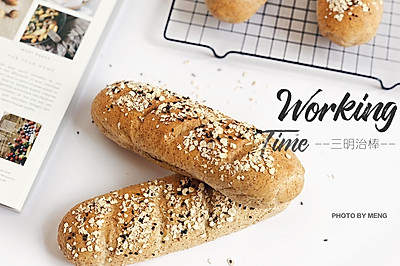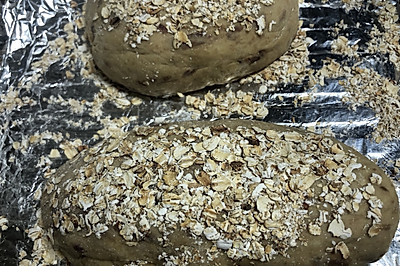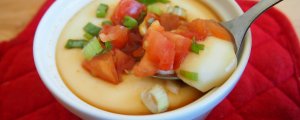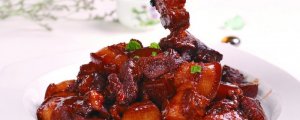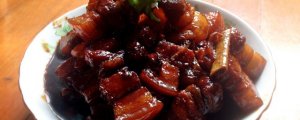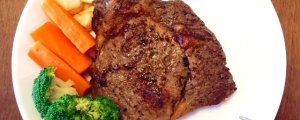
Poolish country whole wheat bread
(156197 views)
Country bread is the most popular staple food. It comes from the common people. The ingredients are usually very simple. There are only flour, water and salt. Da Ren @ EVA Xiaojia makes country bread from poolish seeds. It's faster than cultivating natural yeast seeds. But its flavor is not much worse. The water content of rural bread is greatly increased by the kind of poolish which is prepared in advance. The natural flavor of wheat is fully introduced by long-term fermentation. The baked country bread is crispy on the skin and softer in the interior. It perfectly explains the essence of poolish - simple raw materials to create a richer flavor.
Cooking ingredients
Cooking Steps

Step1:Prepare poolish (polish) 1 day in advance. Mix all materials evenly until there is no dry powder. After covering, refrigerate and ferment for about 17 hours until there are abundant bubbles on the surface. It can be used when the interior is honeycomb.

Step2:Put the main dough materials and polish seeds into the mixing bucket of cm506e chef. After low-speed agglomeration, turn to medium speed kneading to the expansion stage.

Step3:Divide the dough into about 240g. Cover it for standby.

Step4:Put the other dough back into the mixing bucket. Add the dried fruit that has been soaked in advance. Mix at a low speed.

Step5:Round the 2 dough pieces respectively. Put them into the tray. Preheat the cf100a fermentation tank in advance. Select the temperature of 28 ° C and humidity of 70%. Add water to the bottom water pan and humidify it. Put the dough in after the sound prompt is completed. Carry out basic fermentation for about 40 minutes.

Step6:The fermented dough is divided into 2 equal parts. After slightly exhausting, knead the dough respectively. Cover and relax for about 30 minutes. For the relaxed dough, first take a piece of original dough. After exhausting, roll it into a round cake shape and turn it ove

Step7:Take another pasta with stuffing. Air out and knead it. Put it on the original pasta and wrap it. Turn the whole pasta over and round it.

Step8:Put the finished dough in the fermentation basket with the mouth facing up. Cf100a fermentor. The temperature is 32 ℃, the humidity is 80%. The time is 60 minutes. Add water and humidify the bottom water pan. Put the dough into the fermenter for the second fermentation to about 1.5 times the size (preheat the oven at the same time).

Step9:Take out the fermented dough and put it on the cut square oilpaper. Cut the dough as you like before putting it into the oven.

Step10:Cossco960m intelligent oven. Put the slate in the lower layer. Preheat it 250 degrees in advance. Connect the water pipe. Press the steam key first to process the steam. After the steam is ejected, put the bread on the slate with the bread shovel. Press the steam once after the door is closed. Bake for about 10 minutes.

Step11:Bake for 10 minutes. Draw out the bottom oil paper. Adjust the temperature to 230 degrees. Continue baking for 12 minutes.

Step12:At the end of baking, the bread will be put out of the oven immediately. Shake the bread with force and put it on the grid to cool down.
Cooking tips:1. Due to the different water absorption of each flour, do not add all the liquid at one time. Please adjust it according to the dough state. 2. The fermentation time of the Polish species of poolish depends on the dough state. When the surface forms rich bubbles and the tissue is honeycomb, it can be used; when the Polish species of dough is added, the dough has stronger water absorption, the baked bread is more soft, the aging of the bread is delayed, and it also has the unique aroma of long-term fermentation and increases the flavor. 3. There is more whole wheat flour in the dough. The whole wheat flour is rich in vitamins and microelements. It is the flour with the highest nutritional value in the common flour in the market. The bread with the whole wheat flour added will taste rougher than the bread made from the ordinary flour. But it will make the bread more chewy and have a stronger wheat flavor. A small amount of dry fruit added to this bread makes it sweet and sour, which enriches the taste of bread. The addition of steam in baking makes the bread form a crispy shell, but the internal structure keeps toughness. It's more chewy
 Chinese Food
Chinese Food
